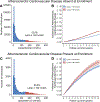Lp(a) (Lipoprotein[a]) Concentrations and Incident Atherosclerotic Cardiovascular Disease: New Insights From a Large National Biobank
- PMID: 33115266
- PMCID: PMC7769893
- DOI: 10.1161/ATVBAHA.120.315291
Lp(a) (Lipoprotein[a]) Concentrations and Incident Atherosclerotic Cardiovascular Disease: New Insights From a Large National Biobank
Abstract
Objective: Lp(a) (lipoprotein[a]) concentrations are associated with atherosclerotic cardiovascular disease (ASCVD), and new therapies that enable potent and specific reduction are in development. In the largest study conducted to date, we address 3 areas of uncertainty: (1) the magnitude and shape of ASCVD risk conferred across the distribution of lipoprotein(a) concentrations; (2) variation of risk across racial and clinical subgroups; (3) clinical importance of a high lipoprotein(a) threshold to guide therapy. Approach and Results: Relationship of lipoprotein(a) to incident ASCVD was studied in 460 506 middle-aged UK Biobank participants. Over a median follow-up of 11.2 years, incident ASCVD occurred in 22 401 (4.9%) participants. Median lipoprotein(a) concentration was 19.6 nmol/L (25th-75th percentile 7.6-74.8). The relationship between lipoprotein(a) and ASCVD appeared linear across the distribution, with a hazard ratio of 1.11 (95% CI, 1.10-1.12) per 50 nmol/L increment. Substantial differences in concentrations were noted according to race-median values for white, South Asian, black, and Chinese individuals were 19, 31, 75, and 16 nmol/L, respectively. However, risk per 50 nmol/L appeared similar-hazard ratios of 1.11, 1.10, and 1.07 for white, South Asian, and black individuals, respectively. A high lipoprotein(a) concentration defined as ≥150 nmol/L was present in 12.2% of those without and 20.3% of those with preexisting ASCVD and associated with hazard ratios of 1.50 (95% CI, 1.44-1.56) and 1.16 (95% CI, 1.05-1.27), respectively.
Conclusions: Lipoprotein(a) concentrations predict incident ASCVD among middle-aged adults within primary and secondary prevention contexts, with a linear risk gradient across the distribution. Concentrations are variable across racial subgroups, but the associated risk appears similar.
Keywords: atherosclerosis; cardiovascular disease; lipoprotein(a); myocardial infarction; secondary prevention.
Figures






Comment in
-
Lp(a) (Lipoprotein[a]), an Exemplar for Precision Medicine: Insights From UK Biobank.Arterioscler Thromb Vasc Biol. 2021 Jan;41(1):475-477. doi: 10.1161/ATVBAHA.120.315549. Epub 2020 Dec 23. Arterioscler Thromb Vasc Biol. 2021. PMID: 33356370 No abstract available.
References
-
- Emerging Risk Factors Collaboration, Erqou S, Kaptoge S, Perry PL, Di Angelantonio E, Thompson A, White IR, Marcovina SM, Collins R, Thompson SG, Danesh J. Lipoprotein(a) concentration and the risk of coronary heart disease, stroke, and nonvascular mortality. JAMA. 2009;302:412–423. doi:10.1001/jama.2009.1063 - DOI - PMC - PubMed
-
- Dahlén G, Ericson C, Furberg C, Lundkvist L, Svärdsudd K. Studies on an extra pre-beta lipoprotein fraction. Acta Med Scand Suppl. 1972;531:1–29. - PubMed
-
- Clarke R, Peden JF, Hopewell JC, Kyriakou T, Goel A, Heath SC, Parish S, Barlera S, Franzosi MG, Rust S, Bennett D, Silveira A, Malarstig A, Green FR, Lathrop M, Gigante B, Leander K, de Faire U, Seedorf U, Hamsten A, Collins R, Watkins H, Farrall M, PROCARDIS Consortium. Genetic variants associated with Lp(a) lipoprotein level and coronary disease. N Engl J Med. 2009;361:2518–2528. doi:10.1056/NEJMoa0902604 - DOI - PubMed
Publication types
MeSH terms
Substances
Grants and funding
LinkOut - more resources
Full Text Sources
Medical
Miscellaneous

